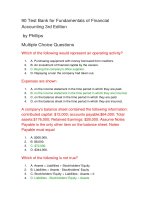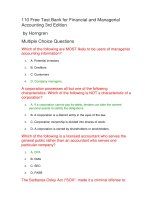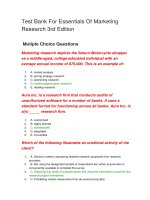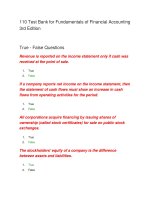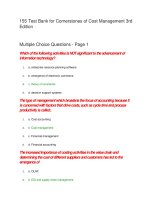Test bank for corporate finance the core 3rd edition berk demarzo
Bạn đang xem bản rút gọn của tài liệu. Xem và tải ngay bản đầy đủ của tài liệu tại đây (166.21 KB, 37 trang )
From />
Corporate Finance, 3e (Berk/DeMarzo)
Chapter 2 Introduction to Financial Statement Analysis
2.1 Firms' Disclosure of Financial Information
1) U.S. public companies are required to file their annual financial statements with the U.S.
Securities and Exchange Commission on which form?
A) 10-A
B) 10-K
C) 10-Q
D) 10-SEC
Answer: B
Diff: 1
Section: 2.1 Firms' Disclosure of Financial Information
Skill: Definition
2) Which of the following is NOT a financial statement that every public company is required to
produce?
A) Income Statement
B) Statement of Sources and Uses of Cash
C) Balance Sheet
D) Statement of Stockholders' Equity
Answer: B
Diff: 2
Section: 2.1 Firms' Disclosure of Financial Information
Skill: Conceptual
3) The third party who checks annual financial statements to ensure that they are prepared
according to GAAP and verifies that the information reported is reliable is the:
A) NYSE Enforcement Board.
B) Accounting Standards Board.
C) Securities and Exchange Commission (SEC).
D) auditor.
Answer: D
Diff: 1
Section: 2.1 Firms' Disclosure of Financial Information
Skill: Definition
4) What is the role of an auditor in financial statement analysis?
Answer: Key points:
1. To ensure that the annual financial statements are prepared accurately.
2. To ensure that the annual financial statements are prepared according to GAAP.
3. To verify that the information used in preparing the annual financial statements is reliable.
Diff: 2
Section: 2.1 Firms' Disclosure of Financial Information
Skill: Conceptual
1
Copyright © 2014 Pearson Education, Inc.
From />
5) What are the four financial statements that all public companies must produce?
Answer:
1. Balance Sheet
2. Income Statement
3. Statement of Cash Flows
4. Statement of Stockholder's Equity
Diff: 2
Section: 2.1 Firms' Disclosure of Financial Information
Skill: Conceptual
2.2 The Balance Sheet
1) Which of the following balance sheet equations is INCORRECT?
A) Assets - Liabilities = Shareholders' Equity
B) Assets = Liabilities + Shareholders' Equity
C) Assets - Current Liabilities = Long Term Liabilities
D) Assets - Current Liabilities = Long Term Liabilities + Shareholders' Equity
Answer: C
Diff: 2
Section: 2.2 The Balance Sheet
Skill: Conceptual
2) Cash is a:
A) long-term asset.
B) current asset.
C) current liability.
D) long-term liability.
Answer: B
Diff: 1
Section: 2.2 The Balance Sheet
Skill: Definition
3) Accounts payable is a:
A) long-term liability.
B) current asset.
C) long-term asset.
D) current liability.
Answer: D
Diff: 1
Section: 2.2 The Balance Sheet
Skill: Definition
2
Copyright © 2014 Pearson Education, Inc.
From />
4) A 30 year mortgage loan is a:
A) long-term liability.
B) current liability.
C) current asset.
D) long-term asset.
Answer: A
Diff: 1
Section: 2.2 The Balance Sheet
Skill: Definition
5) Which of the following statements regarding the balance sheet is INCORRECT?
A) The balance sheet provides a snapshots of the firm's financial position at a given point in
time.
B) The balance sheet lists the firm's assets and liabilities.
C) The balance sheet reports stockholders' equity on the right hand side.
D) The balance sheet reports liabilities on the left hand side.
Answer: D
Diff: 2
Section: 2.2 The Balance Sheet
Skill: Conceptual
6) Dustin's Donuts experienced a decrease in the value of the trademark of a company it acquired
two years ago. This reduction in value results in:
A) an impairment charge.
B) depreciation expense.
C) an operating expense.
D) goodwill.
Answer: A
Diff: 1
Section: 2.2 The Balance Sheet
Skill: Definition
7) Which of the following is an example of an intangible asset?
A) Brand names and trademarks
B) Patents
C) Customer relationships
D) All of the above are intangible assets.
Answer: D
Diff: 1
Section: 2.2 The Balance Sheet
Skill: Definition
3
Copyright © 2014 Pearson Education, Inc.
From />
8) On the balance sheet, short-term debt appears:
A) in the Stockholders' Equity section.
B) in the Operating Expenses section.
C) in the Current Assets section.
D) in the Current Liabilities section.
Answer: D
Diff: 1
Section: 2.2 The Balance Sheet
Skill: Definition
9) On the balance sheet, current maturities of long-term debt appears:
A) in the Stockholders' Equity section.
B) in the Operating Expenses section.
C) in the Current Assets section.
D) in the Current Liabilities section.
Answer: D
Diff: 1
Section: 2.2 The Balance Sheet
Skill: Definition
10) The firm's assets and liabilities at a given point in time are reported on the firm's:
A) income statement or statement of financial performance.
B) income statement or statement of financial position.
C) balance sheet or statement of financial performance.
D) balance sheet or statement of financial position.
Answer: D
Diff: 1
Section: 2.2 The Balance Sheet
Skill: Definition
11) The statement of financial position is also known as the:
A) balance sheet.
B) income statement.
C) statement of cash flows.
D) statement of stockholder's equity.
Answer: A
Diff: 1
Section: 2.2 The Balance Sheet
Skill: Definition
4
Copyright © 2014 Pearson Education, Inc.
From />
Use the following information for ECE incorporated:
Assets
Shareholder Equity
Sales
Net Income
Interest Expense
$200 million
$100 million
$300 million
$15 million
$2 million
12) If ECE's stock is currently trading at $24.00 and ECE has 25 million shares outstanding, then
ECE's market-to-book ratio is closest to:
A) 0.24
B) 4
C) 6
D) 30
Answer: C
Explanation: C) Market to Book = (MV Equity)/(BV Equity) = ($24 × 25 million)/100 million =
6.0
Diff: 2
Section: 2.2 The Balance Sheet
Skill: Analytical
Use the information for the question(s) below.
In November 2009, Perrigo Co. (PRGO) had a share price of $39.20. They had 91.33 million
shares outstanding, a market-to-book ratio of 3.76. In addition, PRGO had $845.01 million in
outstanding debt, $163.82 million in net income, and cash of $257.09 million.
13) Perrigo's market capitalization is closest to:
A) $952.16 million
B) $3,580.14 million
C) $4,168.06 million
D) $4,425.15 million
Answer: B
Explanation: B) Market cap = price × shares outstanding = $39.2 × 91.33 million = $3,580.14
million
Diff: 1
Section: 2.2 The Balance Sheet
Skill: Analytical
5
Copyright © 2014 Pearson Education, Inc.
From />
14) Perrigo's book value of equity is closest to:
A) $952.16 million
B) $3,580.14 million
C) $4,168.06 million
D) $4,425.15 million
Answer: A
Explanation: A) Market to Book = (MV Equity)/(BV Equity) = ($39.2 × 91.33 million)/(BV
Equity) = 3.76;
BV Equity = $952.16 million.
Diff: 2
Section: 2.2 The Balance Sheet
Skill: Analytical
15) Perrigo's enterprise value is closest to:
A) $952.16 million
B) $3,580.14 million
C) $4,168.06 million
D) $4,425.15 million
Answer: C
Explanation: C) Enterprise Value = MV Equity + Debt - Cash = $39.2 × 91.33 +$845.01 $257.09 = $4168.06
Diff: 2
Section: 2.2 The Balance Sheet
Skill: Analytical
6
Copyright © 2014 Pearson Education, Inc.
From />
Use the table for the question(s) below.
Consider the following balance sheet:
Luther Corporation
Consolidated Balance Sheet
December 31, 2009 and 2008 (in $ millions)
Assets
Current Assets
Cash
2009
2008
63.6
58.5
Accounts receivable
55.5
39.6
Inventories
45.9 42.9
Other current assets
6.0
3.0
Total current assets 171.0 144.0
Long-Term Assets
Land
Buildings
Equipment
Less accumulated
depreciation
Net property, plant, and
equipment
Goodwill
Other long-term assets
Total long-term assets
Total Assets
66.6
109.5
119.1
62.1
91.5
99.6
Liabilities and
Stockholders' Equity
2009 2008
Current Liabilities
Accounts payable
87.6 73.5
Notes payable/
short-term debt
10.5
9.6
Current maturities of
long-term debt
39.9 36.9
Other current liabilities
6.0 12.0
Total current liabilities 144.0 132.0
Long-Term Liabilities
Long-term debt
239.7 168.9
Capital lease obligations
----Total Debt
239.7 168.9
(56.1) (52.5)
Deferred taxes
22.8
22.2
239.1 200.7
60.0
-63.0 42.0
362.1 242.7
Other long-term liabilities
----Total long-term liabilities 262.5 191.1
Total liabilities
406.5 323.1
Stockholders' Equity
126.6 63.6
533.1 386.7
Total liabilities and
Stockholders' Equity
533.1 386.7
16) What is Luther's net working capital in 2008?
A) $12 million
B) $27 million
C) $39 million
D) $63.6 million
Answer: A
Explanation: A) NWC = current assets - current liabilities = 144 - 132 = $12 million
Diff: 2
Section: 2.2 The Balance Sheet
Skill: Analytical
7
Copyright © 2014 Pearson Education, Inc.
From />
17) If in 2009 Luther has 10.2 million shares outstanding and these shares are trading at $16 per
share, then Luther's Market-to-book ratio would be closest to:
A) 0.39
B) 0.76
C) 1.29
D) 2.57
Answer: C
Explanation: C) MTB = market cap/book value of equity = (10.2 million × 16)/126.6 =
163.2/126.6 = 1.289
Diff: 2
Section: 2.2 The Balance Sheet
Skill: Analytical
18) If in 2009 Luther has 10.2 million shares outstanding and these shares are trading at $16 per
share, then what is Luther's Enterprise Value?
A) -$63.3 million
B) $353.1 million
C) $389.7 million
D) $516.9 million
Answer: C
Explanation: C) Enterprise value = MVE + Debt - Cash = 10.2 × $16 + 290.1 - 63.6 = 389.7
Diff: 2
Section: 2.2 The Balance Sheet
Skill: Analytical
19) If on December 31, 2008 Luther has 8 million shares outstanding trading at $15 per share,
then what is Luther's market-to-book ratio?
Answer: market-to-book = market value of equity/book value of equity
market-to-book = 8 million × $15/$63.6 = 1.89
Diff: 2
Section: 2.2 The Balance Sheet
Skill: Analytical
20) If on December 31, 2008 Luther has 8 million shares outstanding trading at $15 per share,
then what is Luther's enterprise value?
Answer: Enterprise value = Market value of equity + Debt - Cash
market value of equity = 8 million × $15 = $120 million
Debt = notes payable + current maturities of long-term debt + long-term debt
Debt = 9.6 + 36.9 + 168.9 = 215.4
Cash = 58.5
So, enterprise value = $120 + 215.4 - 58.5 = $276.90
Diff: 2
Section: 2.2 The Balance Sheet
Skill: Analytical
8
Copyright © 2014 Pearson Education, Inc.
From />
2.3 The Income Statement
1) Which of the following statements regarding the income statement is INCORRECT?
A) The income statement shows the earnings and expenses at a given point in time.
B) The income statement shows the flow of earnings and expenses generated by the firm
between two dates.
C) The last or "bottom" line of the income statement shows the firm's net income.
D) The first line of an income statement lists the revenues from the sales of products or services.
Answer: A
Diff: 2
Section: 2.3 The Income Statement
Skill: Conceptual
2) Gross profit is calculated as:
A) Total sales - cost of sales - selling, general and administrative expenses - depreciation and
amortization
B) Total sales - cost of sales - selling, general and administrative expenses
C) Total sales - cost of sales
D) None of the above
Answer: C
Diff: 2
Section: 2.3 The Income Statement
Skill: Conceptual
3) Which of the following is NOT an operating expense?
A) Interest expense
B) Depreciation and amortization
C) Selling, general and administrative expenses
D) Research and development
Answer: A
Diff: 2
Section: 2.3 The Income Statement
Skill: Conceptual
9
Copyright © 2014 Pearson Education, Inc.
From />
Use the information for the question(s) below.
In November 2009, Perrigo Co. (PRGO) had a share price of $39.20. They had 91.33 million
shares outstanding, a market-to-book ratio of 3.76. In addition, PRGO had $845.01 million in
outstanding debt, $163.82 million in net income, and cash of $257.09 million.
4) Perrigo's earnings per share (EPS) is closest to:
A) $0.19
B) $1.79
C) $2.81
D) $3.76
Answer: B
Explanation: B) EPS = (Net Income)/(Shares Outstanding) = $163.82/91.33 = 1.7937
Diff: 2
Section: 2.3 The Income Statement
Skill: Analytical
5) The firm's revenues and expenses over a period of time are reported on the firm's:
A) income statement or statement of financial performance.
B) income statement or statement of financial position.
C) balance sheet or statement of financial performance.
D) balance sheet or statement of financial position.
Answer: A
Diff: 1
Section: 2.3 The Income Statement
Skill: Definition
6) The statement of financial performance is also known as the:
A) balance sheet.
B) income statement.
C) statement of cash flows.
D) statement of stockholder's equity.
Answer: B
Diff: 1
Section: 2.3 The Income Statement
Skill: Definition
10
Copyright © 2014 Pearson Education, Inc.
From />
Use the table for the question(s) below.
Consider the following income statement and other information:
Luther Corporation
Consolidated Income Statement
Year ended December 31 (in $ millions)
2009
Total sales
610.1
Cost of sales
(500.2)
Gross profit
109.9
Selling, general, and
administrative expenses
(40.5)
Research and development
(24.6)
Depreciation and amortization
(3.6)
Operating income
41.2
Other income
--Earnings before interest and taxes
(EBIT)
41.2
Interest income (expense)
(25.1)
Pre-tax income
16.1
Taxes
(5.5)
Net income
10.6
Price per share
Shares outstanding (millions)
Stock options outstanding (millions)
Stockholders' Equity
Total Liabilities and Stockholders'
Equity
2008
578.3
(481.9)
96.4
(39.0)
(22.8)
(3.3)
31.3
--31.3
(15.8)
15.5
(5.3)
10.2
$16
10.2
0.3
$15
8.0
0.2
126.6
63.6
533.1
386.7
7) For the year ending December 31, 2009 Luther's earnings per share are closest to:
A) $0.96
B) $1.04
C) $1.28
D) $1.33
Answer: B
Explanation: B) EPS = Net Income/Shares Outstanding = $10.6/10.2 = $1.04
Diff: 1
Section: 2.3 The Income Statement
Skill: Analytical
11
Copyright © 2014 Pearson Education, Inc.
From />
8) Assuming that Luther has no convertible bonds outstanding, then for the year ending
December 31, 2009 Luther's diluted earnings per share are closest to:
A) $1.01
B) $1.04
C) $1.28
D) $1.33
Answer: A
Explanation: A) Diluted EPS = Net Income/(shares outstanding + options contracts outstanding
+ shares possible from convertible bonds outstanding) = 10.6/(10.2 + 0.3 + 0.0) = $1.01
Diff: 2
Section: 2.3 The Income Statement
Skill: Analytical
2.4 The Statement of Cash Flows
1) Which of the following is NOT a section on the cash flow statement?
A) Income generating activities
B) Investing activities
C) Operating activities
D) Financing activities
Answer: A
Diff: 1
Section: 2.4 The Statement of Cash Flows
Skill: Conceptual
2) Which of the following statements regarding net income transferred to retained earnings is
correct?
A) Net income = net income transferred to retained earnings - dividends
B) Net income transferred to retain earnings = net income + dividends
C) Net income = net income transferred to retain earnings + dividends
D) Net income transferred to retain earnings - net income = dividends
Answer: C
Diff: 2
Section: 2.4 The Statement of Cash Flows
Skill: Conceptual
3) Which of the following is NOT a reason why cash flow may not equal net income?
A) Amortization is added in when calculating net income.
B) Changes in inventory will change cash flows but not income.
C) Capital expenditures are not recorded on the income statement.
D) Depreciation is deducted when calculating net income.
Answer: A
Diff: 1
Section: 2.4 The Statement of Cash Flows
Skill: Conceptual
12
Copyright © 2014 Pearson Education, Inc.
From />
4) Which of the following adjustments to net income is NOT correct if you are trying to calculate
cash flow from operating activities?
A) Add increases in accounts payable
B) Add back depreciation
C) Add increases in accounts receivable
D) Deduct increases in inventory
Answer: C
Diff: 2
Section: 2.4 The Statement of Cash Flows
Skill: Conceptual
5) Which of the following adjustments is NOT correct if you are trying to calculate cash flow
from financing activities?
A) Add dividends paid
B) Add any increase in long term borrowing
C) Add any increase in short-term borrowing
D) Add proceeds from the sale of stock
Answer: A
Diff: 2
Section: 2.4 The Statement of Cash Flows
Skill: Conceptual
13
Copyright © 2014 Pearson Education, Inc.
From />
Use the tables for the question(s) below.
Consider the following financial information:
Luther Corporation
Consolidated Balance Sheet
December 31, 2009 and 2008 (in $ millions)
Assets
Current Assets
Cash
2009
2008
63.6
58.5
Accounts receivable
55.5
39.6
Inventories
45.9 42.9
Other current assets
6.0
3.0
Total current assets 171.0 144.0
Long-Term Assets
Land
Buildings
Equipment
Less accumulated
depreciation
Net property, plant, and
equipment
Goodwill
Other long-term assets
Total long-term assets
Total Assets
66.6
109.5
119.1
62.1
91.5
99.6
Liabilities and
Stockholders' Equity
2009 2008
Current Liabilities
Accounts payable
87.6 73.5
Notes payable/
short-term debt
10.5
9.6
Current maturities of
long-term debt
39.9 36.9
Other current liabilities
6.0 12.0
Total current liabilities 144.0 132.0
Long-Term Liabilities
Long-term debt
239.7 168.9
Capital lease obligations
----Total Debt
239.7 168.9
(56.1) (52.5)
Deferred taxes
239.1 200.7
60.0
-63.0 42.0
362.1 242.7
Other long-term liabilities
----Total long-term liabilities 262.5
Total liabilities
406.5 323.1
Stockholders' Equity
126.6 63.6
533.1 386.7
Total liabilities and
Stockholders' Equity
14
Copyright © 2014 Pearson Education, Inc.
22.8
22.2
533.1 386.7
From />
Luther Corporation
Consolidated Income Statement
Year ended December 31 (in $ millions)
2009
Total sales
610.1
Cost of sales
(500.2)
Gross profit
109.9
Selling, general, and
administrative expenses
(40.5)
Research and development
(24.6)
Depreciation and amortization
(3.6)
Operating income
41.2
Other income
--Earnings before interest and taxes
(EBIT)
41.2
Interest income (expense)
(25.1)
Pre-tax income
16.1
Taxes
(5.5)
Net income
10.6
Dividends Paid
Price per Share
Shares outstanding (millions)
Stock options outstanding (millions)
Stockholders’ Equity
Total Liabilities and Stockholders’
Equity
2008
578.3
(481.9)
96.4
(39.0)
(22.8)
(3.3)
31.3
--31.3
(15.8)
15.5
(5.3)
10.2
5.1
$16
10.2
0.3
5.0
$15
8.0
0.2
126.6
63.6
533.1
386.7
6) For the year ending December 31, 2009 Luther's cash flow from operating activities is:
Answer: Operating cash flow = NI + Depreciation - inc in AR + inc in AP - inc in INV
Operating cash flow = 10.6 + 3.6 - (55.5 - 39.6) + (87.6 - 73.5) - (45.9 - 42.9) = 9.4
Diff: 3
Section: 2.4 The Statement of Cash Flows
Skill: Analytical
15
Copyright © 2014 Pearson Education, Inc.
From />
7) For the year ending December 31, 2009 Luther's cash flow from financing activities is:
Answer: Cash flow from financing:
- dividends paid
(5.1)
+ sale or (purchase) of stock
57.5*
+ increase in ST borrowing
3.9
+ increase in LT borrowing
70.8
Cash flow from financing
127.1
NI transferred to RE(2006) = NI - Dividends paid = 10.6 - 5.1 = 5.5
sale of stock = Equity(2006) - NI transferred to RE(2006) - Equity(2005)
= 126.6 - 5.5 - 63.6 = 57.5
increase in ST borrowing = chg in notes payable + chg in current portion of LT debt
= (10.5 - 9.6) + (39.9 - 36.9) = 3.9
increase in LT borrowing = 239.7 - 168.9 = 70.8
Diff: 3
Section: 2.4 The Statement of Cash Flows
Skill: Analytical
2.5 Other Financial Statement Information
1) In addition to the balance sheet, income statement, and the statement of cash flows, a firm's
complete financial statements will include all of the following EXCEPT:
A) Management discussion and analysis
B) Notes to the financial statements
C) Securities and Exchange Commission's (SEC) commentary
D) Statement of stockholders' equity
Answer: C
Diff: 1
Section: 2.5 Other Financial Statement Information
Skill: Conceptual
2) Off-balance sheet transactions are required to be disclosed:
A) in the management discussion and analysis.
B) in the auditor's report.
C) in the Securities and Exchange Commission's commentary.
D) in the statement of stockholders' equity.
Answer: A
Diff: 2
Section: 2.5 Other Financial Statement Information
Skill: Conceptual
16
Copyright © 2014 Pearson Education, Inc.
From />
3) Details of acquisitions, spin-offs, leases, taxes, and risk management activities are given:
A) in the management discussion and analysis.
B) in the Securities and Exchange Commission's commentary.
C) in the auditor's report.
D) in the notes to the financial statements.
Answer: D
Diff: 2
Section: 2.5 Other Financial Statement Information
Skill: Conceptual
2.6 Financial Statement Analysis
Use the information for the question(s) below.
In November 2009, Perrigo Co. (PRGO) had a share price of $39.20. They had 91.33 million
shares outstanding, a market-to-book ratio of 3.76. In addition, PRGO had $845.01 million in
outstanding debt, $163.82 million in net income, and cash of $257.09 million.
1) Perrigo's market debt to equity ratio is closest to:
A) 0.24
B) 0.50
C) 0.75
D) 0.89
Answer: A
Explanation: A) Market Debt to Equity Ratio = Debt/(MV Equity) = $845.01/($39.2 × 91.33) =
0.236
Diff: 2
Section: 2.6 Financial Statement Analysis
Skill: Analytical
2) Perrigo's debt to equity ratio is closest to:
A) 0.24
B) 0.50
C) 0.75
D) 0.89
Answer: D
Explanation: D) Debt to Equity Ratio = Debt/(BV Equity) = $845.01/(($39.2 × 91.33)/3.76) =
0.887
Diff: 2
Section: 2.6 Financial Statement Analysis
Skill: Analytical
17
Copyright © 2014 Pearson Education, Inc.
From />
Use the table for the question(s) below.
Consider the following balance sheet:
Luther Corporation
Consolidated Balance Sheet
December 31, 2009 and 2008 (in $ millions)
Assets
Current Assets
Cash
2009
2008
63.6
58.5
Accounts receivable
55.5
39.6
Inventories
45.9 42.9
Other current assets
6.0
3.0
Total current assets 171.0 144.0
Long-Term Assets
Land
Buildings
Equipment
Less accumulated
depreciation
Net property, plant, and
equipment
Goodwill
Other long-term assets
Total long-term assets
Total Assets
66.6
109.5
119.1
62.1
91.5
99.6
Liabilities and
Stockholders' Equity
2009 2008
Current Liabilities
Accounts payable
87.6 73.5
Notes payable/
short-term debt
10.5
9.6
Current maturities of
long-term debt
39.9 36.9
Other current liabilities
6.0 12.0
Total current liabilities 144.0 132.0
Long-Term Liabilities
Long-term debt
239.7 168.9
Capital lease obligations
----Total Debt
239.7 168.9
(56.1) (52.5)
Deferred taxes
239.1 200.7
60.0
-63.0 42.0
362.1 242.7
Other long-term liabilities
----Total long-term liabilities 262.5 191.1
Total liabilities
406.5 323.1
Stockholders' Equity
126.6 63.6
533.1 386.7
Total liabilities and
Stockholders' Equity
18
Copyright © 2014 Pearson Education, Inc.
22.8
22.2
533.1 386.7
From />
3) When using the book value of equity, the debt to equity ratio for Luther in 2009 is closest to:
A) 0.43
B) 2.29
C) 2.98
D) 3.57
Answer: B
Explanation: B) D/E = Total Debt/Total Equity
Total Debt = (notes payable (10.5) + current maturities of long-term debt (39.9) + long-term debt
(239.7) = 290.1 million
Total Equity = 126.6, so D/E = 290.1/126.6 = 2.29
Diff: 2
Section: 2.6 Financial Statement Analysis
Skill: Analytical
4) If in 2009 Luther has 10.2 million shares outstanding and these shares are trading at $16 per
share, then using the market value of equity, the debt to equity ratio for Luther in 2009 is closest
to:
A) 1.47
B) 1.78
C) 2.31
D) 4.07
Answer: B
Explanation: B) D/E = Total Debt/Total Equity
Total Debt = (notes payable (10.5) + current maturities of long-term debt (39.9) + long-term debt
(239.7) = 290.1 million
Total Equity = 10.2 × $16 = 163.2, so D/E = 290.1/163.2 = 1.78
Diff: 2
Section: 2.6 Financial Statement Analysis
Skill: Analytical
5) Luther's current ratio for 2009 is closest to:
A) 0.84
B) 0.92
C) 1.09
D) 1.19
Answer: D
Explanation: D) current ratio = current assets/current liabilities = 171/144 = 1.19
Diff: 2
Section: 2.6 Financial Statement Analysis
Skill: Analytical
19
Copyright © 2014 Pearson Education, Inc.
From />
6) Luther's quick ratio for 2008 is closest to:
A) 0.77
B) 0.87
C) 1.15
D) 1.30
Answer: A
Explanation: A) quick ratio = (current assets - inventory)/current liabilities
quick ratio = (144.0 - 42.9)/132 = 0.77
Diff: 2
Section: 2.6 Financial Statement Analysis
Skill: Analytical
7) The change in Luther's quick ratio from 2008 to 2009 is closest to:
A) a decrease of .10
B) an increase of .10
C) a decrease of .15
D) an increase of .15
Answer: B
Explanation: B) quick ratio in 2009 = (171.0 - 45.9)/144 = .87
quick rat io 2008 = (144.0 - 42.9)/132 = .77
so the quick ratio increased by .87 - .77 = .10
Diff: 3
Section: 2.6 Financial Statement Analysis
Skill: Analytical
Use the following information for ECE incorporated:
Assets
Shareholder Equity
Sales
Net Income
Interest Expense
$200 million
$100 million
$300 million
$15 million
$2 million
8) IECE's Return on Assets (ROA) is:
A) 5.0%
B) 8.5%
C) 7.5%
D) 15.0%
Answer: B
Explanation: B) ROA = (Net Income + Interest Expense)/Assets = ($15 million+2 million)/$200
million = 0.085 = 8.5%
Diff: 1
Section: 2.6 Financial Statement Analysis
Skill: Analytical
20
Copyright © 2014 Pearson Education, Inc.
From />
Use the information for the question(s) below.
In November 2009, Perrigo Co. (PRGO) had a share price of $39.20. They had 91.33 million
shares outstanding, a market-to-book ratio of 3.76. In addition, PRGO had $845.01 million in
outstanding debt, $163.82 million in net income, and cash of $257.09 million.
9) Perrigo's price-earnings ratio (P/E) is closest to:
A) 15.96
B) 21.85
C) 29.77
D) 35.64
Answer: B
Explanation: B) price-earnings ratio (P/E) = (M V Equity)/(Net Income) = ($39.2 × 91.33)/
$163.82 = 21.85408
Diff: 2
Section: 2.6 Financial Statement Analysis
Skill: Analytical
21
Copyright © 2014 Pearson Education, Inc.
From />
Use the table for the question(s) below.
Consider the following income statement and other information:
Luther Corporation
Consolidated Income Statement
Year ended December 31 (in $ millions)
2009
Total sales
610.1
Cost of sales
(500.2)
Gross profit
109.9
Selling, general, and
administrative expenses
(40.5)
Research and development
(24.6)
Depreciation and amortization
(3.6)
Operating income
41.2
Other income
--Earnings before interest and taxes
(EBIT)
41.2
Interest income (expense)
(25.1)
Pre-tax income
16.1
Taxes
(5.5)
Net income
10.6
Price per share
Shares outstanding (millions)
Stock options outstanding (millions)
Stockholders' Equity
Total Liabilities and Stockholders'
Equity
2008
578.3
(481.9)
96.4
(39.0)
(22.8)
(3.3)
31.3
--31.3
(15.8)
15.5
(5.3)
10.2
$16
10.2
0.3
$15
8.0
0.2
126.6
63.6
533.1
386.7
10) Luther's Operating Margin for the year ending December 31, 2008 is closest to:
A) 0.5%
B) 0.7%
C) 5.4%
D) 6.8%
Answer: C
Explanation: C) Operating Margin = Operating Income/Sales
OM = 31.3/578.3 = .054 or 5.4%
Diff: 1
Section: 2.6 Financial Statement Analysis
Skill: Analytical
22
Copyright © 2014 Pearson Education, Inc.
From />
11) Luther's Net Profit Margin for the year ending December 31, 2008 is closest to:
A) 1.8%
B) 2.7%
C) 5.4%
D) 16.7%
Answer: A
Explanation: A) Net Profit Margin = Net Income/Total Sales = 10.2/578.3 = .018 or 1.8%
Diff: 1
Section: 2.6 Financial Statement Analysis
Skill: Analytical
12) Luther's earnings before interest, taxes, depreciation, and amortization (EBITDA) for the
year ending December 31, 2009 is closest to:
A) 19.7 million
B) 37.6 million
C) 41.2 million
D) 44.8 million
Answer: D
Explanation: D) EBITDA = EBIT + Depreciation & Amortization = 41.2 + 3.6 = $ 44.8 million
Diff: 1
Section: 2.6 Financial Statement Analysis
Skill: Analytical
13) Luther's return on equity (ROE) for the year ending December 31, 2009 is closest to:
A) 2.0%
B) 6.5%
C) 8.4%
D) 12.7%
Answer: C
Explanation: C) ROE = Net income/shareholders' equity = 10.6/126.6 = .084 or 8.4%
Diff: 2
Section: 2.6 Financial Statement Analysis
Skill: Analytical
14) Luther's return on assets (ROA) for the year ending December 31, 2009 is closest to:
A) 1.6%
B) 6.7%
C) 2.3%
D) 2.6%
Answer: B
Explanation: B) ROA = (Net income + Interest Expense)/total assets.
This is a little tricky in that total assets aren't given in the problem. The student must remember
the basic balance sheet equation A = L + SE. Total Liabilities and Shareholders' Equity is given
and this is the same as total assets. So ROA = (10.6+25.1/533.1 = 0.067 or 6.7%
Diff: 3
Section: 2.6 Financial Statement Analysis
Skill: Analytical
23
Copyright © 2014 Pearson Education, Inc.
From />
15) Luther's price - earnings ratio (P/E) for the year ending December 31, 2009 is closest to:
A) 7.9
B) 10.1
C) 15.4
D) 16.0
Answer: C
Explanation: C) P/E = Price/EPS or Market Cap/Earnings = (10.2 × $16)/$10.6 = 15.4
Diff: 3
Section: 2.6 Financial Statement Analysis
Skill: Analytical
16) Calculate Luther's return of equity (ROE), return of assets (ROA), and price-to-earnings ratio
(P/E) for the year ending December 31, 2008.
Answer: ROE = NI/shareholder equity = 10.2/63.6 = .160 or 16.0%
ROA = NI/total assets
Here total assets are not given, but we know that Total Assets = Total Liabilities + Shareholder
Equity, so ROA = 10.2/386.7 = .026 or 2.6%
P/E = price/EPS or Market Cap/NI = (8.0 × $15)/$10.2 = 11.8
Diff: 2
Section: 2.6 Financial Statement Analysis
Skill: Analytical
Use the following information for ECE incorporated:
Assets
Shareholder Equity
Sales
Net Income
Interest Expense
$200 million
$100 million
$300 million
$15 million
$2 million
17) If ECE's return on assets (ROA) is 12%, then ECE's net income is:
A) $6 million
B) $12 million
C) $22 million
D) $36 million
Answer: C
Explanation: C) ROA = (Net Income + Interest Expense)/Assets = ($ X million + 2 million)/
$200 million = 0.12; X = $22 million
Diff: 1
Section: 2.6 Financial Statement Analysis
Skill: Analytical
24
Copyright © 2014 Pearson Education, Inc.
From />
Use the table for the question(s) below.
Consider the following income statement and other information:
Luther Corporation
Consolidated Income Statement
Year ended December 31 (in $ millions)
2009
Total sales
610.1
Cost of sales
(500.2)
Gross profit
109.9
Selling, general, and
administrative expenses
(40.5)
Research and development
(24.6)
Depreciation and amortization
(3.6)
Operating income
41.2
Other income
--Earnings before interest and taxes
(EBIT)
41.2
Interest income (expense)
(25.1)
Pre-tax income
16.1
Taxes
(5.5)
Net income
10.6
Price per share
Shares outstanding (millions)
Stock options outstanding (millions)
Stockholders' Equity
Total Liabilities and Stockholders'
Equity
2008
578.3
(481.9)
96.4
(39.0)
(22.8)
(3.3)
31.3
--31.3
(15.8)
15.5
(5.3)
10.2
$16
10.2
0.3
$15
8.0
0.2
126.6
63.6
533.1
386.7
18) If Luther's accounts receivable were $55.5 million in 2009, then calculate Luther's accounts
receivable days for 2009.
Answer: Accounts receivable days =
=
Diff: 2
Section: 2.6 Financial Statement Analysis
Skill: Analytical
25
Copyright © 2014 Pearson Education, Inc.
= 33.2 days

